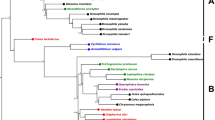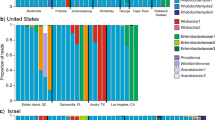Abstract
Symbiotic relationships between organisms are common throughout the tree of life, and often these organisms share an evolutionary history. In turtle ants (Cephalotes), symbiotic associations with bacteria are known to be especially important for supplementing the nutrients that their herbivorous diets do not provide. However, much remains unknown about the diversity of many common bacterial symbionts with turtle ants, such as Wolbachia. Here, we surveyed the diversity of Wolbachia, focusing on one species of turtle ant with a particularly wide geographic range, Cephalotes atratus. Colonies were collected from the entire range of C. atratus, and we detected the presence of Wolbachia by sequencing multiple individuals per colony for wsp. Then, using the multilocus sequence typing (MLST) approach, we determined each individual’s unique sequence type (ST) based on comparison to sequences published in the Wolbachia MLST Database (https://pubmlst.org/wolbachia/). The results of this study suggest that there is a high level of diversity of Wolbachia strains among colonies from different regions, while the diversity within colonies is very low. Additionally, 13 novel variants (alleles) were uncovered. These results suggest that the level of diversity of Wolbachia within species is affected by geography, and the high level of diversity observed among Cephalotes atratus populations may be explained by their wide geographic range.



Similar content being viewed by others
References
Ali H, Muhammad A, Hou Y (2018) Infection density dynamics and phylogeny of Wolbachia associated with coconut hispine beetle, Brontispa longissima (Gestro) (Coleoptera: Chrysomelidae), by multilocus sequence type. Artic J Microbiol Biotechnol. https://doi.org/10.4014/jmb.1712.12019
Ali H, Muhammad A, Sanda Bala N, Hou Y (2018) The endosymbiotic Wolbachia and host COI gene enables to distinguish between two invasive palm pests; coconut leaf beetle, Brontispa longissima and hispid leaf beetle. Octodonta nipae. J Econ Entomol. https://doi.org/10.1093/jee/toy233
Anderson KE, Russell JA, Moreau CS et al (2012) Highly similar microbial communities are shared among related and trophically similar ant species. Mol Ecol 21:2282–2296. https://doi.org/10.1111/j.1365-294X.2011.05464.x
Andrade M De, Urbani C (1999) Diversity and adaptation in the ant genus Cephalotes, past and present. tuttgarter Beitraege Zur Naturkunde. Ser. B Geol. Und Palaeontol
Baldo L, Dunning Hotopp JC, Jolley KA et al (2006) Multilocus sequence typing system for the endosymbiont Wolbachia pipientis. Appl Environ Microbiol 72:7098–7110. https://doi.org/10.1128/AEM.00731-06
Baldo L, Lo N, Werren JH (2005) Mosaic nature of the Wolbachia surface protein. J Bacteriol 187:5406–5418. https://doi.org/10.1128/JB.187.15.5406-5418.2005
Baldo L, Werren JH (2007) Revisiting Wolbachia supergroup typing based on WSP: spurious lineages and discordance with MLST. Curr Microbiol 55:81–87. https://doi.org/10.1007/s00284-007-0055-8
Bandelt HJ, Forster P, Röhl A (1999) Median-joining networks for inferring intraspecific phylogenies. Mol Biol Evol 16:37–48
Bandi C, Anderson TJ, Genchi C, Blaxter ML (1998) Phylogeny of Wolbachia in filarial nematodes. Proc Biol Sci 265:2407–2413. https://doi.org/10.1098/rspb.1998.0591
Betelman K, Caspi-Fluger A, Shamir M, Chiel E (2017) Identification and characterization of bacterial symbionts in three species of filth fly parasitoids. FEMS Microbiol Ecol 25:256. https://doi.org/10.1093/femsec/fix107
Bivand R, Pebesma E, Gomez-Rubio V (2013) Spatial data import and export. Springer, New Yrok
Bleidorn C, Gerth M (2018) A critical re-evaluation of multilocus sequence typing (MLST) efforts in Wolbachia. FEMS Microbiol Ecol 25:256. https://doi.org/10.1093/femsec/fix163
Bordenstein S, Rosengaus RB (2005) Discovery of a novel Wolbachia supergroup in Isoptera. Curr Microbiol 51:393–398. https://doi.org/10.1007/s00284-005-0084-0
Braig HR, Zhou W, Dobson SL, O’Neill SL (1998) Cloning and characterization of a gene encoding the major surface protein of the bacterial endosymbiont Wolbachia pipientis. J Bacteriol 180:2373–2378
Czarnetzki AB, Tebbe CC (2003) Detection and phylogenetic analysis of Wolbachia in Collembola. Environ Microbiol 6:35–44. https://doi.org/10.1046/j.1462-2920.2003.00537.x
Corn ML (1976) The ecology and behavior of Cephalotes atratus, a neotropical ant (Hymenoptera: Formicidae). Harvard University, Cambridge
Fenn K, Blaxter M (2004) Are filarial nematode Wolbachia obligate mutualist symbionts? Trends Ecol Evol 19:163–166. https://doi.org/10.1016/j.tree.2004.01.002
Souza FR, Ramalho DSJ, Morini MSC et al (2009) Identification and characterization of Wolbachia in Solenopsis saevissima fire ants (Hymenoptera: Formicidae) in Southeastern Brazil. Curr Microbiol 58:189–194. https://doi.org/10.1007/s00284-008-9301-y
Floate KD, Coghlin PC, Dosdall L (2011) A test using Wolbachia bacteria to identify Eurasian source populations of cabbage seedpod weevil, Ceutorhynchus obstrictus (Marsham), in North America. Environ Entomol 40:818–823. https://doi.org/10.1603/EN10315
Frost CL, Fernández-Marín H, Smith JE, Hughes WOH (2010) Multiple gains and losses of Wolbachia symbionts across a tribe of fungus-growing ants. Mol Ecol 19:4077–4085. https://doi.org/10.1111/j.1365-294X.2010.04764.x
Funaro CF, Kronauer DJC, Moreau CS et al (2011) Army ants harbor a host-specific clade of Entomoplasmatales bacteria. Appl Environ Microbiol 77:346–350. https://doi.org/10.1128/AEM.01896-10
Hertig M, Wolbach SB (1924) Studies on Rickettsia-like micro-organisms in insects. J Med Res 44(329–374):7
Hu Y, Łukasik P, Moreau CS, Russell JA (2014) Correlates of gut community composition across an ant species (Cephalotes varians) elucidate causes and consequences of symbiotic variability. Mol Ecol 23:1284–1300. https://doi.org/10.1111/mec.12607
Hu Y, Sanders JG, Łukasik P et al (2018) Herbivorous turtle ants obtain essential nutrients from a conserved nitrogen-recycling gut microbiome. Nat Commun 9:964. https://doi.org/10.1038/s41467-018-03357-y
Jaffe K, Caetano FH, Sánchez P et al (2001) Sensitivity of ant (Cephalotes) colonies and individuals to antibiotics implies feeding symbiosis with gut microorganisms. Can J Zool 79:1120–1124. https://doi.org/10.1139/z01-079
Kautz S, Rubin BER, Moreau CS (2013) Bacterial infections across the ants: frequency and prevalence of Wolbachia, Spiroplasma, and Asaia. Psyche (New York). https://doi.org/10.1155/2013/936341
Kautz S, Rubin BER, Russell JA, Moreau CS (2013) Surveying the microbiome of ants: comparing 454 pyrosequencing with traditional methods to uncover bacterial diversity. Appl Environ Microbiol 79:525–534. https://doi.org/10.1128/AEM.03107-12
Kearse M, Moir R, Wilson A et al (2012) Geneious Basic: an integrated and extendable desktop software platform for the organization and analysis of sequence data. Bioinformatics 28:1647–1649. https://doi.org/10.1093/bioinformatics/bts199
Lanan MC, Augusto P, Rodrigues P et al (2015) A bacterial filter protects and structures the gut microbiome of an insect. ISME J. https://doi.org/10.1038/ismej.2015.264
Lanfear R, Frandsen PB, Wright AM et al (2016) PartitionFinder 2: new methods for selecting partitioned models of evolution for molecular and morphological phylogenetic analyses. Mol Biol Evol 34:msw260. https://doi.org/10.1093/molbev/msw260
Martins C, Souza RF, Bueno OC (2012) Presence and distribution of the endosymbiont Wolbachia among Solenopsis spp. (Hymenoptera: Formicidae) from Brazil and its evolutionary history. J Invertebr Pathol 109:287–296. https://doi.org/10.1016/j.jip.2012.01.001
Miller MA, Pfeiffer W, Schwartz T (2010) Creating the CIPRES Science Gateway for inference of large phylogenetic trees. In: Proceedings of the Gateway Computing Environments Workshop (GCE), New Orleans, LA, 14 November 2010. p 1–8
Moreau CS, Bell CD (2013) Testing the museum versus cradle tropical biological diversity hypothesis: phylogeny, diversification, and ancestral biogeographic range evolution of the ants. Evolution 67:2240–2257. https://doi.org/10.1111/evo.12105
Moreau CS, Rubin BER (2017) Diversity and persistence of the gut microbiome of the giant neotropical bullet ant. Integr Comp Biol 57:682–689. https://doi.org/10.1093/icb/icx037
Oksanen J, Kindt R, Legendre P, O’Hara B (2007) The vegan package. Community Ecol Package 10:631–637
Oliver KM, Degnan PH, Burke GR, Moran NA (2010) Facultative symbionts in aphids and the horizontal transfer of ecologically important traits. Annu Rev Entomol 55:247–266. https://doi.org/10.1146/annurev-ento-112408-085305
Panaram K, Marshall JL (2007) F supergroup Wolbachia in bush crickets: what do patterns of sequence variation reveal about this supergroup and horizontal transfer between nematodes and arthropods? Genetica 130:53–60. https://doi.org/10.1007/s10709-006-0020-7
Paradis E, Claude J, Strimmer K (2004) APE: Analyses of Phylogenetics and Evolution in R language. Bioinformatics 20:289–290. https://doi.org/10.1093/bioinformatics/btg412
Paraskevopoulos C, Bordenstein S, Wernegreen JJ, Werren JHBK (2006) Toward a Wolbachia multilocus sequence typing system: discrimination of Wolbachia strains present in Drosophila species. Curr Microbiol 53:388–395. https://doi.org/10.1007/s00284-006-0054-1
Pontieri L, Schmidt AM, Singh R et al (2017) Artificial selection on ant female caste ratio uncovers a link between female-biased sex ratios and infection by Wolbachia endosymbionts. J Evol Biol 30:225–234. https://doi.org/10.1111/jeb.13012
Prezotto LF, Perondini ALP, Hernández-Ortiz V et al (2017) Wolbachia strains in cryptic species of the Anastrepha fraterculus complex (Diptera, Tephritidae) along the neotropical region. Syst Appl Microbiol 40:59–67. https://doi.org/10.1016/J.SYAPM.2016.11.002
R Core Team (2018) R: a language and environment for statistical computing. R Foundation for Statistical Computing, Vienna, Austria. http://www.R-project.org/
Ramalho MO, Bueno OC, Moreau CS (2017) Microbial composition of spiny ants (Hymenoptera: Formicidae: Polyrhachis) across their geographic range. BMC Evol Biol. https://doi.org/10.1186/s12862-017-0945-8
Ramalho MO, Bueno OC, Moreau CS (2017) Species-specific signatures of the microbiome from Camponotus and Colobopsis ants across developmental stages. PLoS ONE. https://doi.org/10.1371/journal.pone.0187461
Ramalho MO, Martins C, Silva LM et al (2017) Intracellular symbiotic bacteria of Camponotus textor, Forel (Hymenoptera, Formicidae). Curr Microbiol. https://doi.org/10.1007/s00284-017-1201-6
Ramalho MO, Vieira AS, Pereira MC et al (2018) Transovarian transmission of Blochmannia and Wolbachia endosymbionts in the Neotropical weaver ant Camponotus textor (Hymenoptera, Formicidae). Curr Microbiol. https://doi.org/10.1007/s00284-018-1459-3
Rowley SM, Raven RJ, McGraw EA (2004) Wolbachia pipientis in Australian spiders. Curr Microbiol 49:208–214. https://doi.org/10.1007/s00284-004-4346-z
Russell JA, Funaro CFC, Giraldo YM et al (2012) A veritable menagerie of heritable bacteria from ants, butterflies, and beyond: broad molecular surveys and a systematic review. PLoS ONE 7:e51027. https://doi.org/10.1371/journal.pone.0051027
Russell JA, Goldman-Huertas B, Moreau CS et al (2009) Specialization and geographic isolation among Wolbachia symbionts from ants and Lycaenid butterflies. Evolution (N Y) 63:624–640. https://doi.org/10.1111/j.1558-5646.2008.00579.x
Russell JA, Moreau CS, Goldman-Huertas B et al (2009) Bacterial gut symbionts are tightly linked with the evolution of herbivory in ants. Proc Natl Acad Sci USA 106:21236–21241. https://doi.org/10.1073/pnas.0907926106
Salunke BK, Salunkhe RC, Dhotre DP et al (2010) Diversity of Wolbachia in Odontotermes spp. (Termitidae) and Coptotermes heimi (Rhinotermitidae) using the multigene approach. FEMS Microbiol Lett 307:55–64. https://doi.org/10.1111/j.1574-6968.2010.01960.x
Sanders JG, Powell S, Kronauer DJC et al (2014) Stability and phylogenetic correlation in gut microbiota: lessons from ants and apes. Mol Ecol. https://doi.org/10.1111/mec.12611
Shoemaker DD, Ahrens M, Sheill L et al (2003) Distribution and prevalence of Wolbachia infections in native populations of the fire ant Solenopsis invicta (Hymenoptera: Formicidae). Environ Entomol 32:1329–1336. https://doi.org/10.1603/0046-225X-32.6.1329
Shoemaker DD, Ross KG, Keller L et al (2000) Wolbachia infections in native and introduced populations of fire ants (Solenopsis spp.). Insect Mol Biol 9:661–673. https://doi.org/10.1046/j.1365-2583.2000.00233.x
Stamatakis A (2014) RAxML version 8: a tool for phylogenetic analysis and post-analysis of large phylogenies. Bioinformatics 30:1312–1313. https://doi.org/10.1093/bioinformatics/btu033
Teixeira L, Ferreira Á, Ashburner M (2008) The bacterial symbiont Wolbachia induces resistance to RNA viral infections in Drosophila melanogaster. PLoS Biol 6:e1000002. https://doi.org/10.1371/journal.pbio.1000002
Van Borm S, Wenseleers T, Billen J, Boomsma J (2003) Cloning and sequencing of wsp encoding gene fragments reveals a diversity of co-infecting Wolbachia strains in Acromyrmex leafcutter ants. Mol Phylogenet Evol 26:102–109. https://doi.org/10.1016/S1055-7903(02)00298-1
Vieira AS, Ramalho MO, Martins C, Bueno OC (2017) Microbial diversity associated with Atta sexdens rubropilosa leaf-cutting ants. Curr Microbiol 74(10):1216–1225
Wenseleers T, Ito F, Van Borm S et al (1998) Widespread occurrence of the micro-organism Wolbachia in ants. Proc Biol Sci 265:1447–1452. https://doi.org/10.1098/rspb.1998.0456
Werren JH (1997) Biology of Wolbachia. Annu Rev Entomol 42:587–609. https://doi.org/10.1146/annurev.ento.42.1.587
Zhou W, Rousset F, O’Neill S (1998) Phylogeny and PCR–based classification of Wolbachia strains using wsp gene sequences. Proc R Soc London B Biol Sci 265:509–515
Acknowledgements
We thank the National Science Foundation Research Experiences for Undergraduates (REU) program for making this opportunity possible (NSF DBI 1559779). This work was also supported by a grant from the National Science Foundation to C.S.M. (NSF DEB 1900357).
Author information
Authors and Affiliations
Corresponding author
Ethics declarations
Conflict of interest
All authors declare that they have no conflict of interest.
Additional information
Publisher's Note
Springer Nature remains neutral with regard to jurisdictional claims in published maps and institutional affiliations.
Rights and permissions
About this article
Cite this article
Kelly, M., Price, S.L., de Oliveira Ramalho, M. et al. Diversity of Wolbachia Associated with the Giant Turtle Ant, Cephalotes atratus. Curr Microbiol 76, 1330–1337 (2019). https://doi.org/10.1007/s00284-019-01722-8
Received:
Accepted:
Published:
Issue Date:
DOI: https://doi.org/10.1007/s00284-019-01722-8




